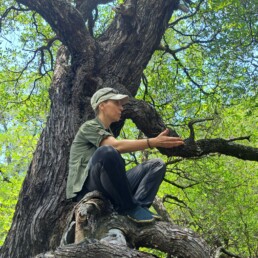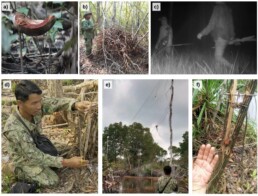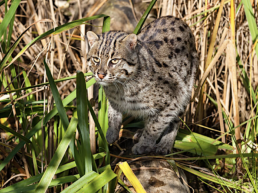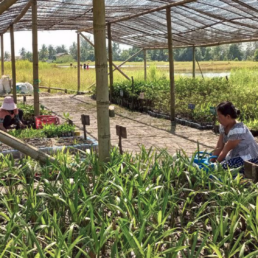Goals
- To support development, coordination and implementation of multi-stakeholder anti-poaching activities including patrolling and data collection in the mangroves of Koh Kong.
- To produce biodiversity reports, conduct local consultations and strengthen local conservation activities, in order to process a proposal to obtain legal protection of the Prey Nup mangroves.
Field Partner
Fishing Cat Ecological Enterprise – a Cambodia-based ecological enterprise that collaborates with foundations, governments, development agencies, non-profits, as well as private sector and individuals to support the harmonious co-existence of nature and people.
Location


The FCEE story starts in 2015 with the first ever photo of the threatened Fishing Cat in coastal Cambodia, spurring our work to protect the species. Today, our goal is to protect and restore habitats that fishing cats call home. We’re protecting and reviving Cambodia’s mangroves for communities, biodiversity and climate adaptation. – Vanessa Herranz Muñoz of FCEE
Protection of the Prey Nup mangrove forest
The Prey Nup mangrove forest is situated in Tuol Totueng commune, Prey Nup district, Sihanoukville province, along the delta of Preaek Kampong Smach river, within the Stung Kampong Smach Key Biodiversity Area (KBA), which covers 10,508 ha of both mangroves and rice fields. Mangrove forest area along the coast covers 3,288 ha on both sides of the bay, and patches of mangrove fringe the river for approximately 19 km inland, covering another 2,000 ha.
Project Activities
1. Conducting systematic biodiversity surveys and establishing wildlife and mangrove forest monitoring systems.
2. Engaging local stakeholders during meetings and workshops to train on antipoaching activities
3. Contributing to local management plans and implementation of conservation activities including patrolling, law enforcement, and taking steps toward establishment of a carbon credit initiative.
4. Working with community groups on mangrove restoration and replanting.

Anti-poaching support in the mangroves of Koh Kong
Peam Krasop Wildlife Sanctuary and Koh Kapik Ramsar Site, Cambodia hold one of the largest and densest mangrove forests remaining in Southeast Asia.
Overexploitation of wildlife and non-timber forest products (NTFPs), land clearance for agriculture, land grabbing, illegal hunting and fishing are major threats to this ecosystem.
Project Activities
1. Enhance Ranger Capacity and Coordination:
Provide comprehensive training for rangers on wildlife identification, emergency response, GPS navigation, report writing, and data management.
Conduct SMART training if feasible, in collaboration with relevant authorities. Train rangers on law enforcement, evidence collection, and community engagement. Facilitate regular coordination meetings and joint patrols between rangers, local police, and conservation authorities. Ensure rangers have necessary field equipment for effective patrols.

2. Strengthen Patrol Planning and Implementation:
Develop detailed patrol plans identifying high-risk areas, routes, and frequency. Assist in developing SOPs for patrolling, incident response, and data collection, especially related to anti-poaching efforts. Establish a centralized monitoring and reporting system (SMART) for tracking patrol activities and outcomes. Promote the use of innovative technologies like camera traps, drones, and mobile apps for efficient patrols. Build capacity among local law enforcement for effective investigation and prosecution.
3. Strengthen Community Engagement and Participation:
Collaborate with community protected area committees to address local concerns. Engage with local communities to build trust and encourage participation in conservation efforts. Establish community-based monitoring systems for reporting suspicious activities. Offer incentives and alternative livelihoods to reduce reliance on unsustainable practices.

4. Enhance Coordination and Information-Sharing:
Facilitate regular meetings and information exchange among government agencies involved in biodiversity protection. Establish a rapid response mechanism for addressing illegal activities swiftly.
5. Monitoring, Evaluation, and Adaptive Management:
Develop a monitoring and evaluation framework to assess the effectiveness of patrolling efforts, focusing on indicators like poaching reduction.
Analyze patrol data regularly to identify trends, hotspots, and emerging threats. Conduct periodic evaluations to adjust the action plan based on findings.

About FCEE
The Foundation for Cambodian Ecological Enterprises (FCEE) is a Cambodia-based ecological enterprise that collaborates with foundations, governments, development agencies, non-profits, the private sector, and individuals to support the harmonious co-existence of nature and people. FCEE envisions Cambodian wetland ecosystems that are biodiversity-rich, healthy, and resilient to climate change.
Missions
- To investigate, protect, restore, and rewild the Cambodian wetland ecosystems.
- To ensure conservation of threatened species within them and empower local communities to be their guardians.

Restoring mangroves at FCEE tree nursery
FCEE Team
FCEE’s team consists of professionals and experts in wildlife and habitat research, ecosystem restoration, social research, community engagement, and capacity building. With shared passions in conservation, innovation, and entrepreneurism, the team designs and conducts research, delivers assessments, implements projects, and builds technical capacity to protect biodiversity and strengthen the resilience of ecosystems and communities in Cambodia.
Connect with FCEE

The Fishing Cat (Prionailurus viverrinus) is a fascinating and elusive wild cat uniquely adapted to life in wetlands. Found primarily in the wetlands of South and Southeast Asia, these medium-sized cats are about twice the size of domestic cats and possess a glossy yellowish-gray double-layered coat that serves as a water barrier and insulation. Known for their exceptional swimming abilities, Fishing Cats have partially webbed feet and ears that close shut when submerged, aiding them in hunting. Their curious call, reminiscent of a duck, adds to their mystique. Mostly nocturnal, these adept hunters prey on fish, frogs, and crustaceans by wading into water and skillfully using their paws to scoop their catch.
Camera traps shine a light on new populations in Cambodia. “We now have the confirmation of Fishing Cats in at least three sites in very different areas,” – Vanessa Herranz Muñoz, of the Cambodian Fishing Cat Project. Mongabay
FCEE has been working with local volunteers and land owners with a long-standing interest in the protection of the Prey Nup mangroves since 2021. They have deployed camera-traps throughout the largest areas of mangroves and results have shown that there is a very rich biodiversity and important populations of threatened species.
Mammals
The Long-tailed Macaque, also known as the crab-eating macaque, is a lively and adaptable primate. Recognized by its notably long tail, which is often longer than its body, this macaque is highly intelligent and social. Living in groups that can range from a few individuals to several dozen, they exhibit complex social behaviors and are known for their resourcefulness in both forested and urban environments. Despite their adaptability, they face challenges from habitat loss and human-wildlife conflict.

Photo: Charles J. Sharp
The Smooth-coated Otter is a highly social and endearing creature, known for its sleek fur and playful nature. Living in close-knit families of up to 20 members, these otters thrive on companionship and teamwork, making them a delight to observe in the wild. Despite their charm, they face numerous threats, placing them in a vulnerable position in the wild.

Photo : Mprasannak
Plants
FCEE has recently conducted a rapid survey of mangrove flora and recorded 40 plant species, with most areas showing mature forest characteristics of high diversity and complexity.

Poaching
Poaching is major threat, over the last few years, FCEE has recorded a severe increase in poaching impacting threatened species such as Vulnerable Fishing Cat (one young cat was found dead with signs of snare injuries in 2022), Smooth-coated Otter (camera-trap photos of otters missing hands during 2023), and Endangered Long-tailed Macaque.

Poaching devices and evidence found by FCEE and MoE rangers in PKWS/KKRS. a) Coconuts used to attract macaques; b) hide used by poachers to wait for macaques; c) poachers with guns photographed on a camera-trap; d) MoE ranger demonstrates the functioning of a snare; e) bird net; f) civet trap.
To protect keystone species like Fishing Cats it’s necessary to protect their specialized mangrove habitat and all the other wildlife that lives there. Mangroves are essential not only as wildlife habitat but for sequestering carbon and protecting the coastal lowlands from rising seas. I am working closely with Vanessa and her impressive all-Cambodian team to develop this project, and I have seen their work first hand. They are doing all the right things…collecting data on the elusive Fishing Cats and other wildlife, developing anti-poaching/anti-snaring patrols, and working with the government and local community to protect this valuable and vulnerable habitat. – Doug Bender, ICF Board Member and a key supporter of this project











